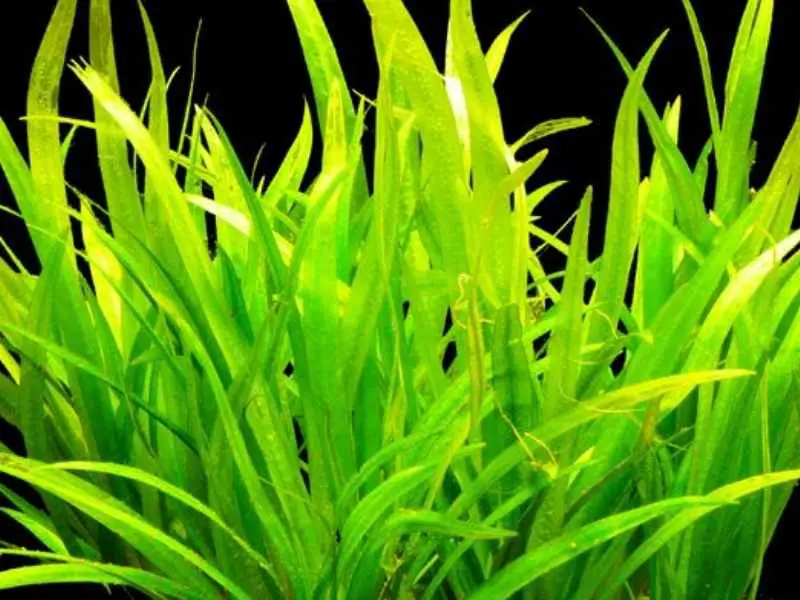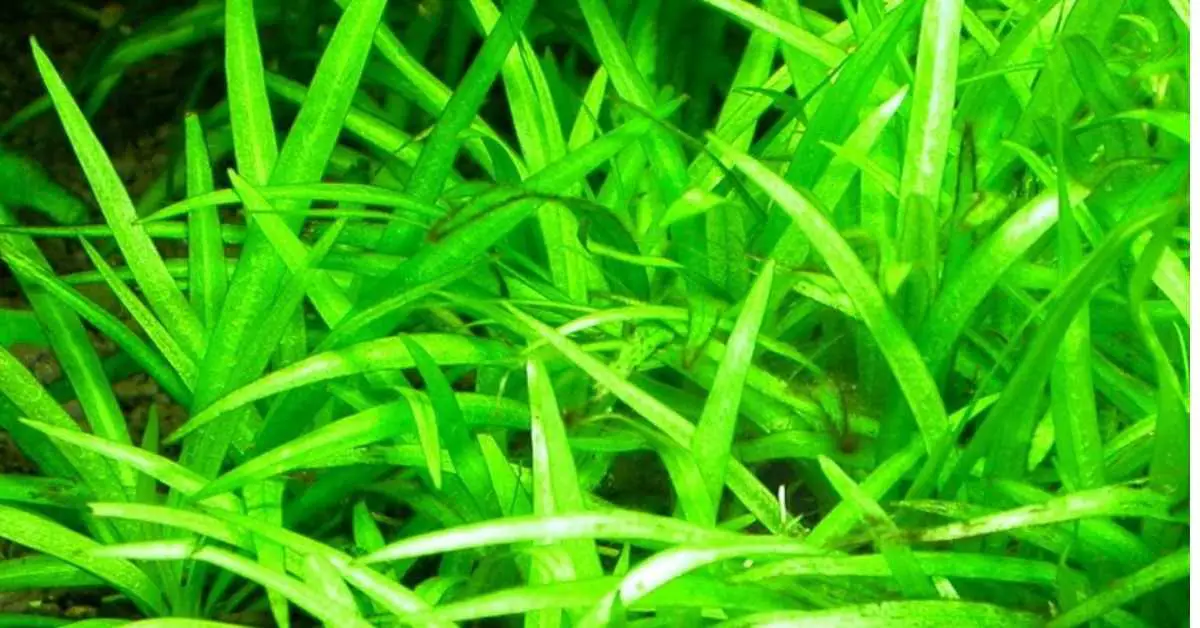The Bolivian sword-Helanthium bolivianum is a popular aquarium plant that can be found in many pet stores. It is easy to care for and makes a great addition to any aquarium. It can be used as either a foreground or background plant, and provides plenty of cover for fish hiding from predators. It grows quickly and will soon fill out the tank, making it an ideal choice for those looking for an attractive, and low-maintenance aquatic plants.
This versatile plant can also be used as an accent or focal point in your garden pond or landscape design. It is also effective at shading and cooling the water, making it an ideal choice for ponds and aquariums with fish or other aquatic life. Bolivian sword is easy to care for and will thrive in most types of water conditions.
Bolivian sword is also a great choice for planted tanks because it grows quickly and forms dense clumps. It looks especially nice when grown with other swords or tall plants like Hygrophila corymbosa.
You might also read: Amazon frogbit plant-Limnobium laevigatum
Systematic Position
Kingdom: Plantae
Clade: Angiosperms
Order: Alismatales
Family: Alismataceae
Genus: Helanthium
Species: Helánthium boliviánum (Rusby) Lehtonen & Myllys
Habitat
Bolivian sword is a beautiful, delicate plant that can be found in the Bolivian rainforest. It is a wetland plant that can be found in the tropics and subtropics. It is often found near aquatic plants like lilies, lotuses, and other aquatic ferns. They grow well in areas with dense vegetation where they can hide from predators.
Physical Appearance
Bolivian sword is a stem plant with long, narrow leaves that can grow 2-3 feet in length. The leaves are dark green and have a reddish-brown edge that can reach up to 12 inches long. The leaves are stiff and sword-like, hence the name Bolivian sword. In late spring, flowers will bloom on slender stems near the top of the plant. The flowers are small and white, and grow in clusters along the stem. This plant does best when planted in groups of three or more. It makes an excellent focal point in any tank and adds visual interest when planted in groups.

Bolivian sword Quick Facts
Scientific Name: Helánthium boliviánum
Origin: Bolivia, Southern South America and Tropical South America
Growth rate: Fast
Size: 2-3 feet in length
Lighting requirement: Medium-High (2-4 watts per gallon)
Placing: Midground, Foreground
Minimum tank size: 20 gallons
Water Temperature: 68-82 degrees F
Water pH: 6.5-7.5
Hardness: 0- 14° dKH
Propagation: Runners, Cutting off daughter plants
Suitable Nitrate level: 10 – 50 mg/l
Carbon Dioxide (CO2) Level: 10 – 40 mg/l
Phosphate (PO₄) level: 0.1 – 3 mg/l
Potassium (K) level: 5 – 30 mg/l
Iron requirement (Fe): 0.01 – 0.5 mg/l
Care level: Easy
Housing and Care Facts
Bolivian sword is a popular aquarium plant that hasQuick many uses. It can be used as a background plant, midground plant, or even a foreground plant. It is also great for beginners because it is easy to care for. To keep your Bolivian sword healthy, it is important to provide the correct water parameters and light levels. The ideal pH range for this plant is 6.5-7.5, and the recommended light level is 2-4 watts per gallon.
This plant does well in slightly acidic water conditions with deep water and has a lot of dissolved oxygen. It prefers temperatures of 68-82 degrees F and moderate to fast-flowing water currents. It can grow immersed or submersed condition and makes an attractive addition to any planted aquarium.
In order to keep your Bolivian swords looking their best, you will need to trim them regularly with scissors or clippers so that the plant does not become too bushy and overgrown. You should also trim any dead or wilted leaves from time to time in order to promote new growth.
The plant can tolerate some saltwater, but it does best in fresh water. It can add beauty to any tank while helping to keep the water clean by absorbing nutrients from the substrate.
Housing for Bolivian sword is not difficult, but there are a few things to keep in mind.
The first consideration is substrate. This plant does best when grown in a nutrient-rich substrate that will allow their roots to grow deep. A good option is to use a planting mix specifically designed for aquatic plants. You can also create your own mix by combining one part potting soil with one part sand or gravel.
It is important to provide plenty of space for Bolivian swords, as they can grow quite large. A minimum tank size of 20 gallons should be used if you are keeping just a few plants, but larger tanks are preferable if you want more than five or six swords growing happily together.
Lighting is another important factor when it comes to housing Bolivian swords successfully. They need bright light conditions in order to thrive, so place your tank near a window or use an artificial light source such as fluorescent tubes or LED lights.
Bolivian sword requires nutrient-rich water to stay healthy so regular fertilization is important. In this case, you can use liquid fertilizer or tablets specifically made for aquatic plants.
And lastly, make sure there is enough room for the plant to grow – it will need at least 12 inches of space between plants or else it may become entangled with other plants in your tank.
Propagation
Bolivian sword is a popular aquarium plant. It is easy to propagate and can be grown in a wide range of water conditions.
To propagate Bolivian sword, simply cut off a stem from the parent plant and replant it in fresh water. Cutting should be about 4 inches long from an existing healthy plant. In this case, you should remove the plant from the aquarium and cut it into several smaller clumps using a sharp knife or scissors. Replant the clumps in fresh water and wait for them to establish new roots before returning them to the aquarium.
Strip off the leaves from the bottom 2/3 of the cutting and dip it into room temperature water for about 10 seconds. Place the cutting into a glass or vase of fresh water (change the water every few days) with its topmost leaves above the surface of the water. Within 2-4 weeks you should see new roots forming at nodes along the stem; once these are 1/4 inch long, transplant your new Bolivian sword into soil.
You can also divide an existing clump of plants by pulling them apart into smaller pieces. Be sure to leave at least one healthy leaf on each division so the plants can continue to photosynthesize.
Compatibility
The Bolivian sword is compatible with many other plants and can be used as part of a planted tank setup. It does best when planted in groups or clusters and will help create an attractive aquascape. When grown properly, this plant will provide shelter for fish and invertebrates.
As far as compatibility goes, Bolivian swords should do well with most other fish species provided there is enough room for them to swim. However, they may not be the best choice for tanks with small fish or shrimp as they can easily become lunch.
Diseases
There are several diseases that can affect Bolivian sword. The most common is a fungal infection, which can cause the leaves to turn brown and die. Another disease is called chlorosis, which causes the leaves to turn yellow and eventually die. These diseases can cause significant damage to the plant, and in some cases may even kill it. Both of these diseases can be treated with fungicides or other chemicals, but it’s important to diagnose them correctly and treat them early for best results.
One common disease is bacterial leaf spot. This disease causes small black spots on the leaves of the plant. The spots will eventually grow larger, and may turn yellow or brown. The bacteria that causes this disease can also infect the stems of the plant, causing them to rot.
Another common disease is fungal root rot. This disease affects the roots of the plant, causing them to become soft and mushy. The fungus can also spread up through the stem of the plant, eventually killing it.
Another common disease for Bolivian swords is red slime algae (RSA). RSA is a type of algae that forms slimy colonies on surfaces in your aquarium water. It often has a reddish hue and can be very difficult to get rid of once it takes hold. To prevent RSA from becoming a problem in your tank, make sure you keep up with regular water changes and filter maintenance.
To help prevent these diseases from affecting your plants, you should make sure to:
- Keep your plants healthy by providing adequate water and nutrients.
- Remove any dead leaves or debris from around your plants.
- Avoid over-watering your plants.
If you notice any signs of this disease, it’s important to treat it quickly with an appropriate medication.
Conclusion
Bolivian sword plants (Helanthium bolivianum) are a great choice for planted aquariums, as they are easy to care for and they can tolerate wide range of water conditions. They can grow quite large, so be sure to provide enough space in your tank. They prefer moderate light and moderate to high levels of dissolved oxygen, so be sure to include plenty of plants and aeration in your tank if you want to keep these beauties. This species can propagate easily via stem cuttings taken from the side shoots.

